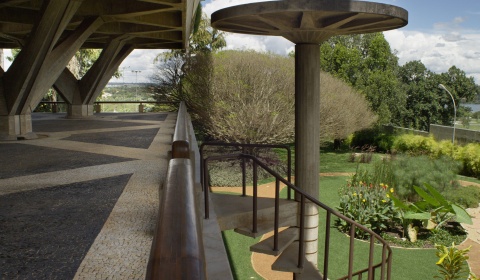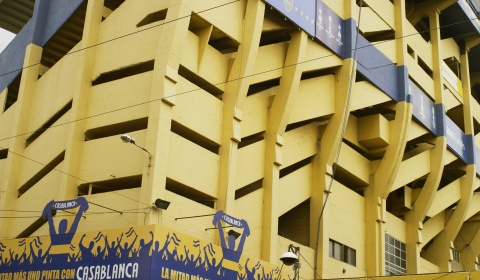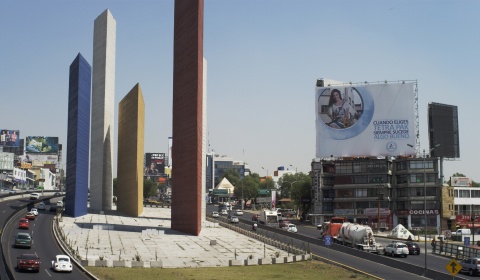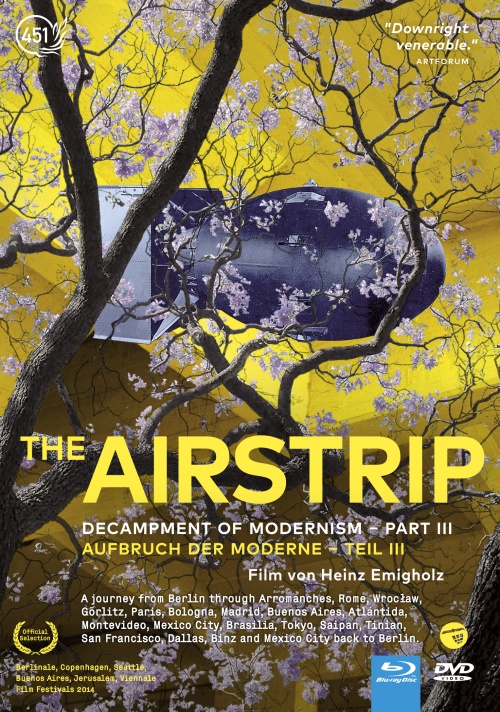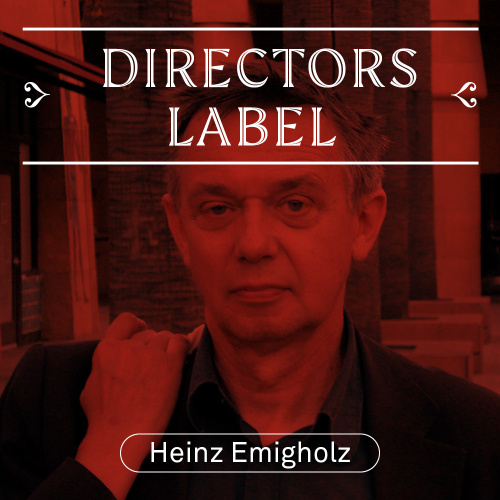
The Airstrip
GER 2014, 108 min
An architectural journey from Berlin back to Berlin – into the abyss.
Synopsis
Imagine an airspace into which a bomb has been dropped. The bomb has not reached the site of its detonation, but there is no way to stop its speedy approach. The time between the bomb’s release and its explosion is neither the future (for the ineluctable destruction has not yet happened) nor the past (which is unavoidably about to be extinguished). The flight time of the bomb thus describes absolute nothingness, the zero hour, consisting of all the possibilities that in just a moment will no longer exist. Thus, this story will end before it has begun; here it is told in defiance: an architectural journey from Berlin through Arromanches, Rome, Wrocław, Görlitz, Paris, Bologna, Madrid, Buenos Aires, Atlántida, Montevideo, Mexico City, Brasilia, Tokyo, Saipan, Tinian, Tokyo, San Francisco, Dallas, Binz and Mexico City back to Berlin – into the abyss.
After PARABETON and PERRET IN FRANCE AND ALGERIA, THE AIRSTRIP is the third part of the series DECAMPMENT OF MODERISM.
Streaming-Info
Rent or buy the movie on our Vimeo channel.
Language: English
Film kaufen
VOD
451-Vimeo
DVD
451-Alive Shop
Press reviews
“The Airstrip” is Emigholz’s latest investigation of modernity via architectural form - and the third chapter in his “Decampment of Modernism” series. The film presents a global panorama of structures including stadia, shopping centers, airports and prisons, through which to quietly mediate upon war, capitalism, ideology and national identity. With music from Kreidler. (Barbican London, 2014)
In his new film Heinz Emigholz traces links that reach from Modernism’s concrete cult to the ‘concrete culture of war’, as the film-maker says. The last outstanding image analyst of German Cinema was never more sparkling. (Andreas Busche, epd film, 2014)
Wakeling gives us some indication how to interpret his findings in an early reference to ‘mosaic theory,’ defined thusly: ‘disparate items of information which individually have no utility to their possessor can take on added significance when combined with other items of information.’ A more compelling expression of this idea—likewise concerned with the presence of the past within the present – can be found in The Airstrip – Decampment of Modernism, Part III by Heinz Emigholz, who has been making films since the early 1970s. (In the company of the artists presenting new work here, this makes him downright venerable – Abrantes was born in 1984, and Wakeling is only a few years older.) Beginning with sculptor Reinhold Begas’s 1901 Prometheus, read as an allegory for the self-image of Germany under Wilhelm II, then shuttling to Rome’s Pantheon, Emigholz traces the interleaving histories of modernist architecture and twentieth-century political catastrophe, photographing buildings by Viktor Sulčič, Eladio Dieste, and Luis Barragán, while pursuing a wending route from Normandy to South America to Saipan, where Fat Man and Little Boy were loaded for delivery to the Empire of Japan. All the while, Emigholz elaborates and frustrates the elusive connection between what one US veteran, quoted in on-screen text, describes as “that indescribable cleanliness which one feels with bombs away” and a new cleanliness of design. (Artforum, 2014)
‘Saipan, Tinian landmarks star in German film out in spring’ A German filmmaker travelled to the Northern Marianas last year to shoot scenes for a movie that is scheduled for release this spring. Heinz Emigholz, who founded the production company Pym Films in 1978, was on Saipan and Tinian from April 5 to 12, 2012, with colleague and fellow artist Ueli Etter to work on the film The Airstrip – Decampment of Modernism. The two-hour film is the last installment of a series of films about modern architecture that have been shown worldwide in cinemas, film festivals and were especially acclaimed in the United States, said Emigholz. “It will contain several scenes with concrete ruins of Japanese military buildings on Saipan, and “Northfield” on Tinian with its concrete loading pits for the atomic bombs Little Boy and Fat Man,” he told Saipan Tribune, adding that the principal photography for the movie was done all over the world in 62 days. Emigholz, 64, said that his reasons to come to Saipan were manifold. He has studied and written about the Pacific War for decades, and loved the film Anatahan by Josef von Sternberg since childhood. Rat Beach, a story about 1945 Saipan written by William Styron, also piqued the interest of the professor for Experimental film at Berlin University of the Arts. What finally convinced him, however, was the book The Roman Pantheon: The Triumph of Concrete by the late American war veteran David Moore and published by the University of Guam, which he came across when he did a film about the historical and one of the best-preserved structures. “He was a civil engineer and his book is the best about the Pantheon I ever read,” Emigholz told Saipan Tribune, saying that Moore’s book also led to his discovery of Moore’s website, www.battleofsasipan.com. “I definitely will come back to Saipan and stay some time to work on a book.” When Emigholz returned to Germany following his brief stay in the Northern Marianas, members of the German group Kreidler approached him and asked him to do a video for a track in their new album Den released last Oct. 5. Founded in 1994, Kreidler combines electronic and analog instruments and is categorized by critics, depending on the publication, as electronic music, pop, avant-garde, post rock, ambient, neoclassical, krautrock or electronica. “I listened to their material, liked it and decided to do clips for all seven tracks,” said Emigholz, adding that he used materials shot in the CNMI for the videos of two tracks. He used the shot during the ride to the loading pits on Tinian for the video for Rote Wüste (Red Desert), which was released a month before Kreidler’s album came out “and became very popular.” Meanwhile, Emigholz used shots of La Fiesta, the site of the Japanese Banzai attack on July 5, 1945, for the video of Sun. (Clarissa V. David, Saipan Tribune, 9.1.2013)
Awards and Festivals
- Berlinale Forum, 2014
- Copenhagen Architecture Festival, 2014
- Festivales de Buenos Aires, 2014
- IndieLisboa International Film Festival, 2014
- Jeonju International Film Festival, 2014
- Subversive Film Festival Croatia, 2014
- Seattle International Film Festival, 2014
- Jerusalem International Film Festival, 2014
- Milano Design Film Festival, 2014
- Architecture on Film & City Visions at the Barbican London, 2014
- Viennale – Vienna International Film Festival, 2014
- Seville Film Festival, 2014
- CGAI-Filmoteca de Galicia, the film archive of Galicia, FIAF Associate, 2014
- CulturArts – Generalitat Valenciana (Valencia Film Archive), 2014
- Filmoteca de Andalucía, 2014/2015
- Migrating Forms Film Festival at BAMcinématek New York, 2014
- Centro Cultural, Goethe-Institut São Paulo, 2015
- Instituto Moreira Salle, Goethe-Institut Rio de Janeiro, 2015
- Chicago Architecture Biennial, 2015
- Tabakalera – Centro Internacional de Cultura Contemporánea, 2016
Additional Texts
A Journey to Saipan
Heinz Emigholz
I can name the exact moment. It was the afternoon of 23 October 2010 when, after all those years, I resolved to fly to the Northern Mariana Islands, to Saipan, from there to cross over to Tinian. Those who not only have heard of Pearl Harbor, but also wince at the names of Midway, Wake, Marcus, Marshall, Kwajalein, Eniwetok, Gilbert, Truk, Iwo Jima, Attu, Kiska, the Salomons, Bougainville, Rabaul, Ulithi, Guadalcanal, Espiritu Santo, Guam, Palau, Mindanao, Luzon, Tarawa and Okinawa, will understand this decision. I confess that I owe my life to the first two atom bombs and, as a German, to the Japanese fanaticism that led to their being dropped on Japan. But now I wanted to be where it all culminated, in the western Pacific. I felt like a turtle that swims back thousands of miles to the place of its birth to bury its eggs in the sand – on the beach where many soldiers had to die, soldiers to whom I owed my life and a childhood sheltered by the balance of terror. Life, if it lasts long enough, is easier to narrate as a frame tale. This literary form was conceived to propagate meaning, even if, as solace, it consists solely of distant echoes. In the 1950s, the two cinemas in our small town – the Corso and the Odeon – were full of American B movies about the war in the Pacific. Alternating with films with Fuzzy, these black-and-white films could be seen there almost every Sunday. My first confrontation with Anatahan, by Josef von Sternberg, later my favourite film and favourite director, also came at this time. The first face of an actor that lastingly inscribed itself in my consciousness, along with that of Al St. John as ‘Fuzzy’, was Lee Marvin’s, who appeared in many of these films as the sturdy rock in the midst of battle. While shooting our film in Saipan, I learned that Marvin, a US Marine, had been awarded a Purple Heart for being severely wounded in the assault on Mount Tapochau on Saipan in June 1944. There is something about this island. While researching for the film Parabeton, I had run across the book The Roman Pantheon: the Triumph of Concrete by the American civil engineer David Moore. In it, he describes the recipe for Roman cement and the construction art of the Roman construction legionnaires. Moore’s website has two other topics: the prostate cancer of war veterans and The Battle of Saipan, in which Moore took part as a ‘Seabee’ in June 1944 – as one of the pioneers of the US Navy Construction Battalions that built the airfields on Saipan. On 20 July 2009, William Styron’s autobiographical story Rat Beach appeared in The New Yorker. I read it because Styron had saved my life in 1990 with his elucidations on the ‘Black Dog’ – a term Churchill found for his depressions – in his book Darkness Visible. Reading Rat Beach was staggering und crucial for my decision of 23 October. In Spring 1945, as a 20-year-old officer, Styron had to train his unit to land on Japan’s home islands. His text describes his mortal fear in the face of a fanatic, desperate enemy who would stop at nothing. He describes the roar of the motors of the B-29s taking off day after day from Tinian, the neighbouring island to the south, to bombard Japanese cities. Among them were the two B-29 Superfortresses, the Enola Gay and the Bockscar, with the atomic bombs Little Boy and Fat Man on board; dropping them saved not only his life. On my return flight from Saipan to Tokyo, I glimpsed a rainbow over the volcano, active again since 2003, on the neighbouring island to the north, Anatahan. I decided to shoot the film Anatahan II as a sequel to The Airstrip. The only architectures on it are huts, caves and those of the plants. Unless the people who occasionally visit the island, uninhabited since 1990, count as buildings.
Watch Movie
VOD
451-Vimeo
DVD
451-Alive Shop
Credits
Director, Screenplay and Director of Photography
Heinz Emigholz
Assistant Camera
Till Beckmann
Editor
Heinz Emigholz, Till Beckmann
Music
Kreidler
Man at the Beach
Ueli Etter
Narrator
Natja Brunckhorst
Original Sound
Till Beckmann, Heinz Emigholz, Ueli Etter, Lilli Kuschel, Markus Ruff, Christin Wilke
Sound Design
Jochen Jezussek, Christian Obermaier
Sound Mixer
Jochen Jezussek
Postproduction and Animation
Till Beckmann
Production Assistant Europa
Markus Ruff, Alex Jovanovic, Lilli Kuschel, Luca Pisciotta, Katharina Zollner
Production Assistant South America
Laura Bierbrauer, Elisa Miller, Lukas Rinner, Christin Wilke
Production Assistant Saipan
Ueli Etter
Producers
Frieder Schlaich, Irene von Alberti
Produced by
Filmgalerie 451
In Coproduction with
WDR (Reinhard Wulf)
Founded by
Die Beauftragte der Bundesregierung für Kultur und Medien - BKM, Medienboard Berlin-Brandenburg, Filmförderung Hamburg-Schleswig-Holstein
DVD-Details
Extras
Short film TWO MUSEUMS (18 min.), building by building navigation, Presskit
Language
German, English
Country Code
Code-free
System
NTSC / Color
Length
108 min + 18 min Extras
Aspect Ratio
16:9 anamorph (Blu-ray: 1080p)
Sound Format
DD 5.1 + 2.0
Set Content
Softbox (Set Content: 2), DVD and Blu-ray Disc
Release Date
27.02.2015
Rating
No age distriction
Distribution Details
Screening Format
DCP (4K, 25fps, 5.1)
Blu-ray Disc (HD)
Aspect Ratio
HD, 1:1,66
Language
German, English
Subtitles
English
Promotion Material
A1-Poster
License Area
Worldwide
Rating
No age distriction


